• Allergy & immunity remedies
• Nutrients for a healthy pregnancy
• Noodle bowl recipes

• Allergy & immunity remedies
• Nutrients for a healthy pregnancy
• Noodle bowl recipes



Zinc, a vital nutrient, plays important roles in growth and development, immune response, reproduction, and neurological function. It may benefit people who have agerelated degenerative diseases, including Parkinson’s disease and Alzheimer’s.
Zinc deficiency appears to play an important role in the onset of many illnesses, including autoimmune diseases. Research has also found an association between depression and low zinc levels in the blood.
Zinc cannot be stored in the body in significant amounts so you must obtain it regularly through food or supplementation. In developed countries, zinc deficiency may occur in the elderly, vegans, pregnant and lactating women, and those with alcohol dependency. People with sickle cell disease or chronic gastrointestinal disorders (such as ulcerative colitis or Crohn’s disease) may also be at risk.
Common in cold lozenges and remedies, zinc occurs naturally in certain foods. It is almost always found in multivitamin/mineral dietary supplements. Consumers can also choose zinc supplements made from different forms of zinc, including zinc sulfate, zinc acetate, and zinc gluconate. ●
SELECTED SOURCES “Zinc,” Linus Pauling Institute, http://lpi.oregonstate.edu, 5/19 • “Zinc,” Office of Dietary Supplements, National Institutes of Health, http://ods.od.nih.gov/factsheets/zinc, 10/4/22 • “Zinc deficiency,” L. Maxfield et al., StatPearls, 6/28/23


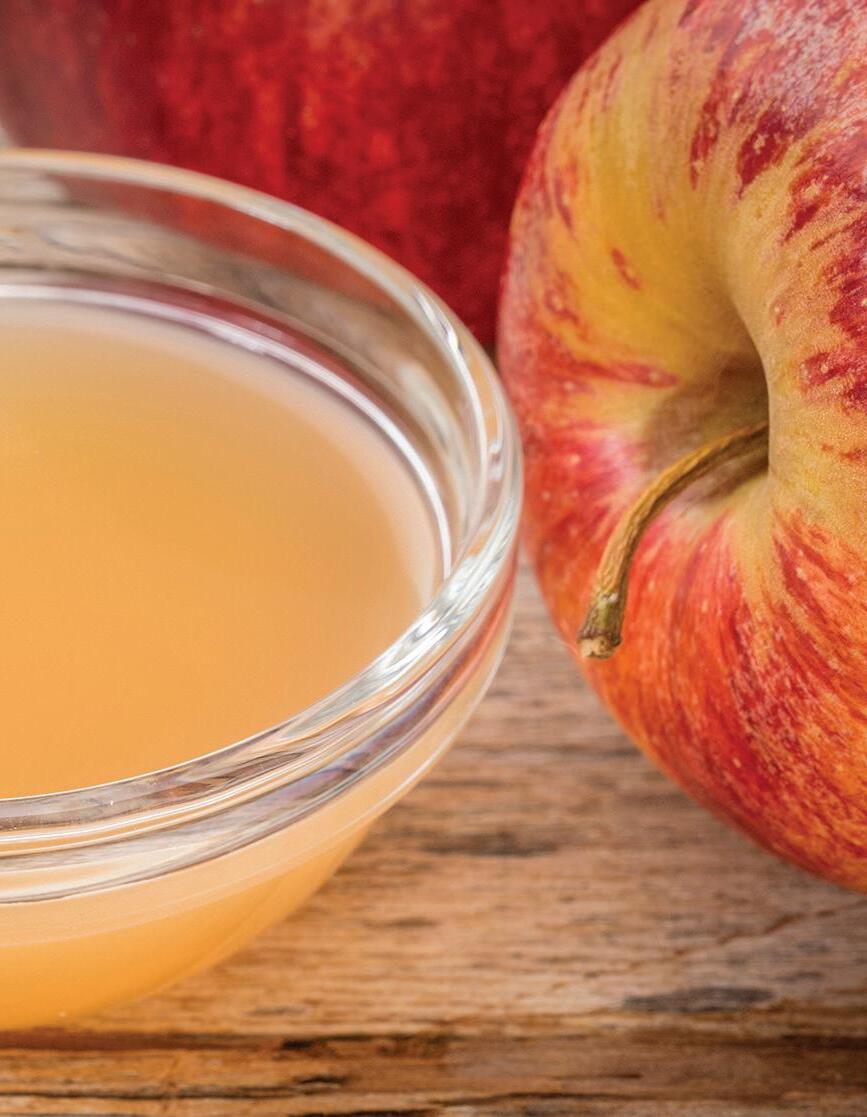


Now that summer’s over, children are back in school and we all lose a bit of that vacation luster. A good job for September is to think about staying healthy throughout the coming fall and winter.
The colder months bring fall allergies and the beginning of flu and cold season—not to mention COVID and RSV, two viruses that continue to plague us. To get your immune system ready, we have advice in the feature “Family Health in Changing Seasons” on page 16.
Everyone loves autumn for its abundance of everything apple, including pie and cider. See page 25 for the health boosts that come from apple cider vinegar, including blood sugar control, digestive health, and help with weight loss.
A nutrient that’s important for the immune system, zinc also supports metabolism, wound healing, and the senses of taste and smell (page 2). Support your kids’ health as they head back to the classroom by learning about nutrients they need: Our kids’ nutrition chart on pages 22 and 23 lists vitamins and minerals, the foods that offer them, and recommended dosages for supplements.
If you or someone you love is pregnant or planning to have a baby, check out our “Healthy Pregnancy” article on page 20. And everyone can benefit from learning strategies to deal with high cholesterol during September, which is National Cholesterol Education Month. See page 28.
Let’s head to the kitchen now to learn about cooking with whole grains (page 26) and to whip up a skillet apple pancake that serves four (page 5)! Pho and ramen bowls take center stage in this month’s food feature, which beings on page 12.
Be sure to enjoy lots of time outdoors, too!
Mary Ann O’Dell, MS, RDN

Contributing Writers
Mary Ann O’Dell MS, RDN
Sally Karlovitz CN
Chief Content Officer and Strategist Lynn Tryba (Lynn.Tryba@TasteforLife.com)
Contributing Editors
Lisa Fabian, Rich Wallace
Associate Editor Kelli Ann Wilson
Creative Director
Michelle Knapp
Custom Graphics Manager
Donna Sweeney
Chief Operating Officer
Amy Pierce
Customer Service 800-677-8847
CustomerService@TasteforLife.com
Client Services Director - Retail Judy Gagne (x128)
Client Services Director - Advertising & Digital Ashley Dunk (x190)
Vice President – Retail Sales and Strategic Partnerships Anna Johnston (Anna.Johnston@TasteforLife.com)
Chairman and Founder T. James Connell
Taste for Life® (ISSN 1521-2904) is published monthly by CCI, 155 Washington Street, Keene NH 03431, 603-283-0034 (fax 603-283-0141); © 2024 Connell Communications, Inc. All rights reserved. Subscription rates: $29.95. This magazine is not intended to provide medical advice on personal health conditions, nor to replace recommendations made by health professionals. The opinions expressed by contributors and sources quoted in articles are not necessarily those of the editor or the publisher. Advertisers and advertising agencies assume liability for all content of advertising and for any claims arising therefrom. Information appearing in Taste for Life may not be reproduced in whole or in part without express permission of the publisher.
Creative and Sales Offices 155 Washington Street, Keene NH 03431 603-283-0034




From Preppy Kitchen Super Easy by John Kanell ($35, Simon Element, 2024)
For the Dutch Baby
²⁄³ c whole milk, cold
3 large eggs, cold
²⁄³ c all-purpose flour
2 Tbsp granulated sugar
1 tsp vanilla extract
¼ tsp ground cinnamon
¼ tsp salt
1½ Tbsp unsalted butter
For the Apples
1 Tbsp unsalted butter
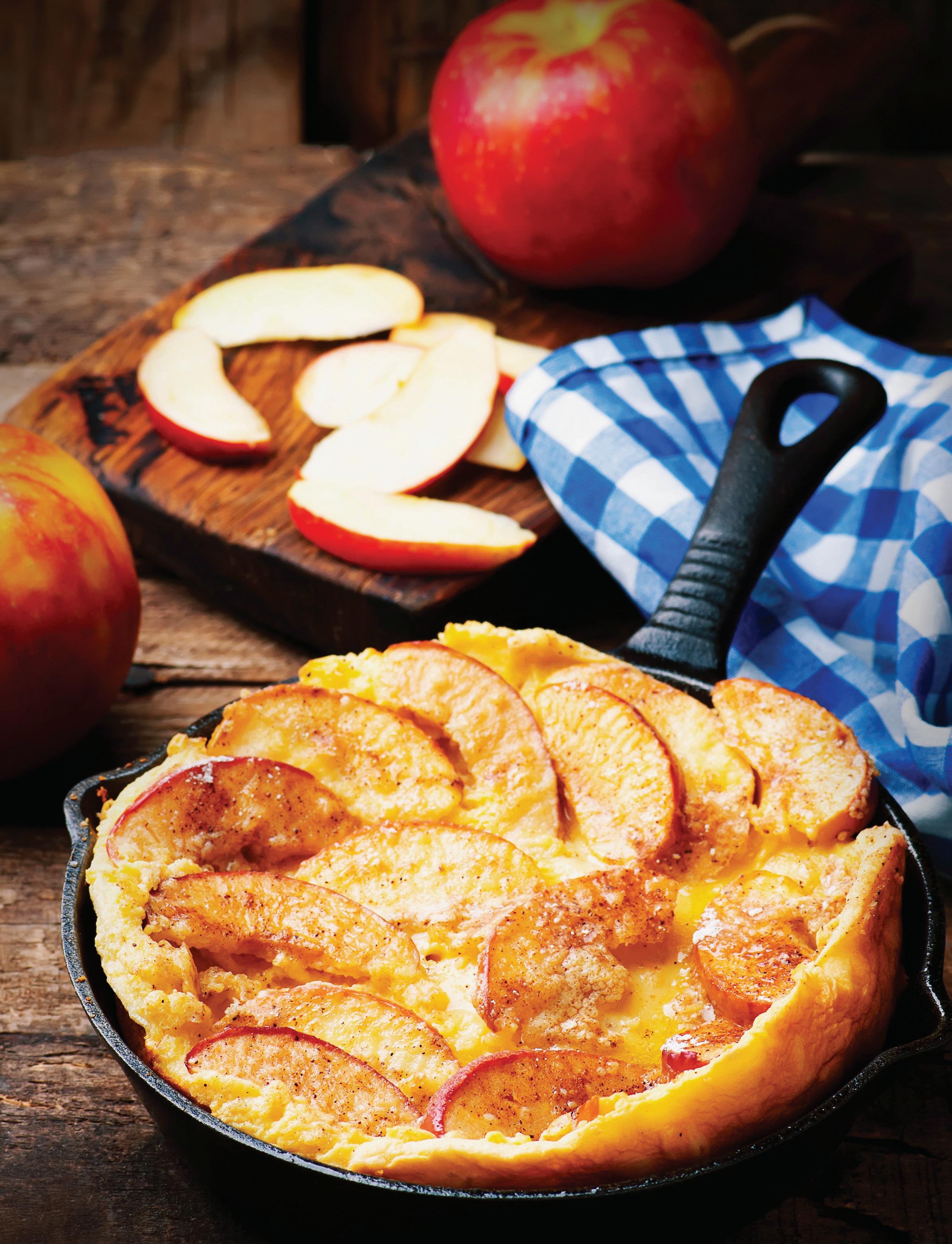
60 min prep time serves 4
(It’s important to follow this order and have liquid ingredients go in first to prevent flour from clumping.) Blend or process for 20 seconds on high to blend well. Allow batter to rest at room temperature for 20 minutes or refrigerate it in blender pitcher for up to 24 hours.
2. Place a 10-inch cast-iron skillet in oven and preheat to 425°.
3. When oven has preheated, carefully remove skillet (it will be hot!) and add the 1½ tablespoons of butter, swirling until melted. Give batter a quick stir and pour it into hot skillet. Bake for 20 to 25 minutes, until pancake is dramatically puffed and deep golden brown around edges.
liquid has thickened, 5 to 10 minutes. Remove pan from heat and cover to keep warm.
6. Serve pancake immediately (before it deflates and loses its impressive puff!) topped with apples.
*Any type of apple will work here. Keep in mind that crisper varieties such as Honeycrisp, Cosmic Crisp, and Granny Smith will take slightly longer to cook than softer varieties like Jonagold, Golden Delicious, or McIntosh. To speed things up a touch, you can keep the pan covered while the apples simmer.
2 large apples, peeled, cored, and thinly sliced*
¹⁄³ c firmly packed light brown sugar
1 Tbsp fresh lemon juice
½ tsp ground cinnamon
⅛ tsp allspice
⅛ tsp ground ginger Pinch salt
1. Make Dutch baby: In a blender or food processor, combine milk and eggs. Then add flour, sugar, vanilla, cinnamon, and salt.
4. While pancake bakes, make apples: Melt the 1 tablespoon of butter in a large skillet over medium-high heat, swirling pan occasionally to evenly coat bottom. Add apple slices and stir to coat with butter. Add brown sugar, lemon juice, cinnamon, allspice, ginger, and salt. Stir to combine.
5. Cook, stirring occasionally, until sugar dissolves and juices begin bubbling, about 5 minutes. Reduce heat to medium and continue cooking, stirring occasionally, until apples have softened to your liking (falling apart and melting or on the crisper side) and
Kitchen Note: If you refrigerate the batter before using it, let it sit at room temperature while the oven preheats. Blend the batter again just before baking. Feel free to play with the fruit you use here—sliced peaches, pears, berries, and even pineapple would work well in this recipe. For fruits that are juicier, you may want to add a slurry of 1 teaspoon of cornstarch mixed with 2 teaspoons of water to the skillet, which will help thicken the mixture.
Per serving: 331 Calories, 8 g Protein, 143 mg Cholesterol, 49 g Carbohydrates, 30 g Total sugars (18 g Added sugars), 3 g Fiber, 12 g Total fat (6 g sat), 360 mg Sodium, ★★ Vitamin B2 (riboflavin), B12, ★ Vitamin A, Calcium, Phosphorus
Plant-based diets scored extremely well in a new report on 48 reviews of various studies. The authors concluded, “Plantbased diets appear beneficial in reducing cardiometabolic risk factors, as well as CVDs [cardiovascular diseases], cancer risk, and mortality.” Blood pressure control, management of blood sugar, and improved body mass index were among the benefits cited.
SELECTED SOURCES “Cardiovascular health and cancer risk associated with plant based diets: An umbrella review” by A. Capodici et al., PLOS ONE, 5/15/24 • “Two decades of studies suggest health benefits associated with plant-based diets,” PLOS, 5/15/24

A new study touts the benefits of strawberries for heart health and glucose control. “A diet low in fruit is among the top three risk factors for cardiovascular disease and diabetes,” said co-author Britt Burton-Freeman, PhD, a professor at the Illinois Institute of Technology. “Adding as little as one cup of strawberries a day to your diet may show beneficial effects on your cardiovascular health.”
SOURCE “New study shows strawberries may lower cardiovascular disease risk and improve glucose control,” www.EurekAlert.org, 7/1/24

Eating baby carrots three times a week appears to boost carotenoid levels enough to have a meaningful health benefit. The gains were even more significant when participants in a new study also took a multivitamin/ mineral supplement.
According to the authors, carotenoids—which give many fruits and vegetables their red, orange, and yellow colors—can be measured in the skin to assess fruit and vegetable consumption. “Higher levels of skin carotenoids are associated with increased antioxidant protection and a lower risk of chronic diseases such as heart disease and certain cancers,” they wrote.
“Our findings suggest that a small, simple dietary modification incorporating baby carrots as a snack—can significantly increase skin carotenoid accumulation,” said researcher Mary Harper Simmons.
SELECTED SOURCES “Effect of a four-week intervention using baby carrots or multivitamin supplements on skin-carotenoid scores in young adults” by M.H. Simmons et al., Samford University, 6/24 • “Trying to eat more vegetables? Snacking on carrots might help,” American Society for Nutrition, 6/30/24


Limiting junk food may reduce the risk of memory problems, according to new research. The study determined that soft drinks, chips, cookies, and other “ultra-processed” foods may contribute to cognitive decline and stroke. Such foods tend to be high in added sugar, fat, and salt, but low in protein and fiber.
SELECTED SOURCES “Associations between ultraprocessed food consumption and adverse brain health outcomes” by V.M. Bhave et al., Neurology, 6/11/24 • “Eating more ultra-processed foods tied to cognitive decline, stroke,” American Academy of Neurology, 5/22/24
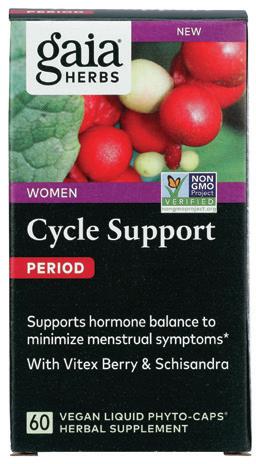



Introducing new formulas to support a woman’s monthly cycle. Cycle Support promotes hormone balance with vitex berry to minimize menstrual symptoms.* Cycle Serenity balances mood with clinically-studied saffron.* Use separate for specific support, or together for full-spectrum support.
Hydrate your body and support beauty from the inside out. Sip your way to silky soft skin with this taste of the tropics. Coconut water is enhanced with sustainably sourced hydrolyzed marine collagen peptides to help reduce the appearance of wrinkles, while acai provides a potent antioxidant boost.* No added sugar and no preservatives.
Energize your muscles and relieve tension with this topical magnesium oil spray. Infused with peppermint and eucalyptus, this daily supplement is the perfect addition to your self-care routine. Trust in the power of magnesium to help soothe tired muscles and achy joints, and to help you feel your best every day!*

This aromatic hydrosol complex supports a healthy brain, neurological function, and nervous system response.* The quick acting formula acts as an oxygenrich natural antioxidant.* Experience the benefits of wild, unprocessed nature, including oregano, rosemary, sage, and pomegranate.
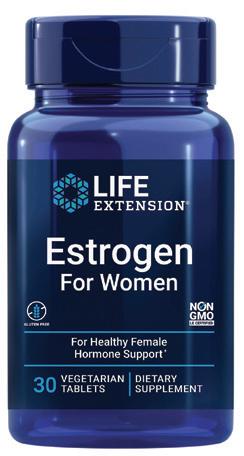
This plant-based supplement is designed to support healthy estrogen metabolism and support against common menopausal discomforts such as hot flashes and night sweats.* The formula supplies soy isoflavones and potent botanicals such as broccoli, licorice and chasteberry extracts, dong quai, and more. Once a day tablet.

Gorgie
Good for you and good tasting, this energy drink combines the right amount of flavor and fizz. Formulated with green tea caffeine, L-theanine, and B vitamins, it’s an energy drink with benefits. Zero grams of sugar and no nasty sugar replacements. Sip sip enjoy!

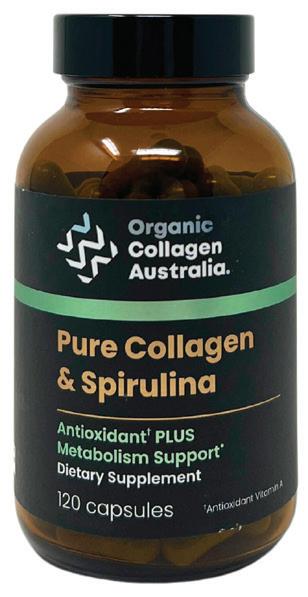
Improve brain function with this exciting new brain support supplement designed to help boost Brain-Derived Neurotrophic Factor (BDNF), a neuroprotein critical for a healthy brain.* This formula helps boost memory, learning, concentration, focus, and more with L-citrulline, L-tryptophan, and coffeeberry.
Get a nutrient and antioxidant boost with collagen derived from Australian pasture-raised and grass-fed organic cattle and spirulina. This combination supplies protein and chromium to support metabolism and energy production, plus beta carotene to support glowing skin.* Paleo and keto friendly.
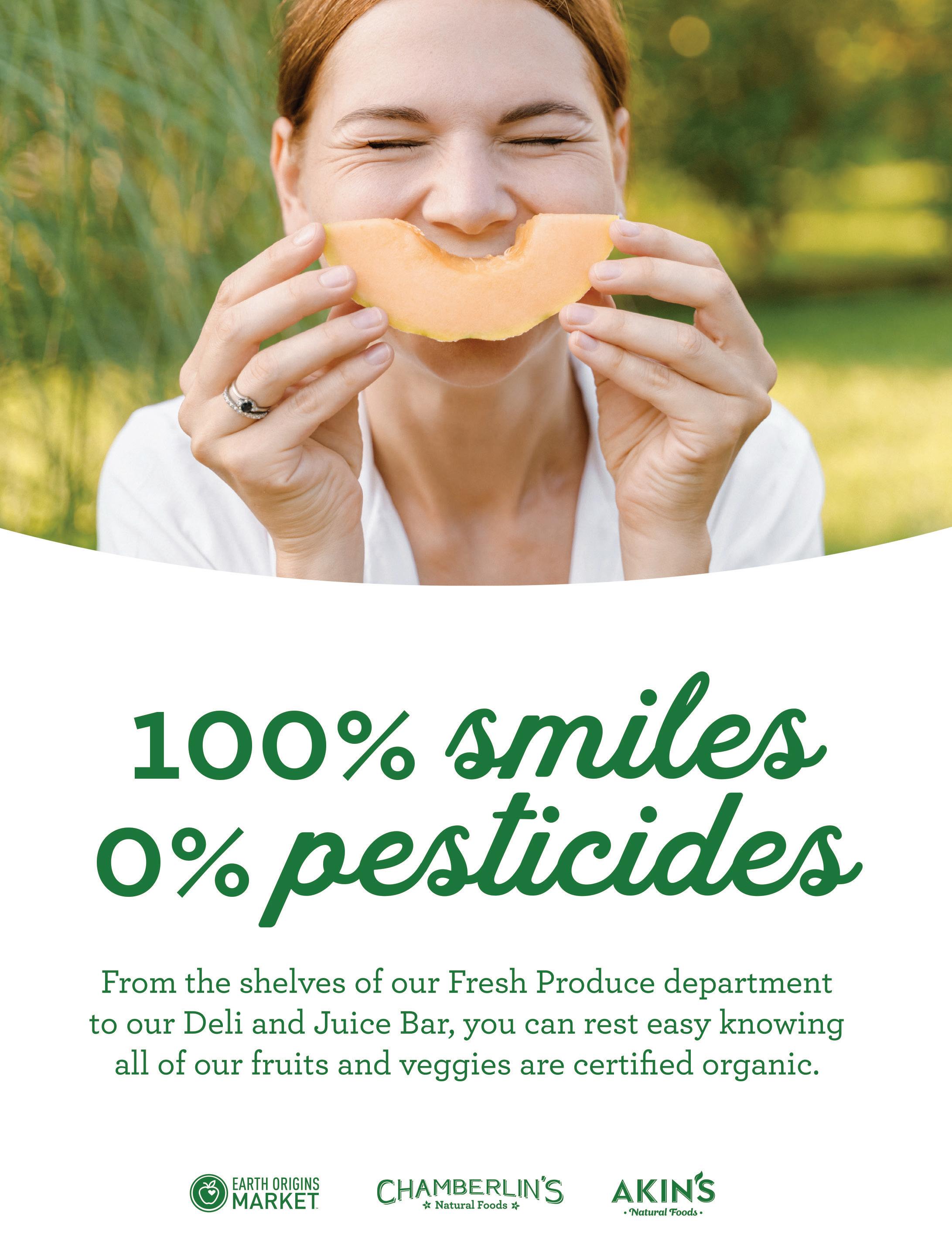
















Noodle soups never seem to lose their popularity. Is it any wonder why? These comforting and steaming bowls of flavor can be enjoyed any time the craving strikes. Here are some Asian-inspired dishes featuring rice noodles. There’s even one with noodles made from zucchini!
From Mildreds Easy Vegan by Mildreds ($32.99, Hamlyn, 2023)
3½ oz dried rice vermicelli noodles
2 oz sesame oil, plus extra for drizzling
¼ small Chinese cabbage or pak choi (about 4 oz), sliced
About 10 sugar snap peas, sliced
½ red bell pepper, sliced
3-4 green onions, sliced
½ carrot, sliced into julienne strips
1 Tbsp soy sauce or tamari
35 min
prep time
serves 2
4½ oz crumbled tofu (seasoned with 1 tsp kala namak, which is black salt or use regular salt; ¼ tsp ground turmeric; and black pepper)
3½ oz bean sprouts
For the Singapore spice mix
½ Tbsp curry powder
½ tsp soft light brown sugar
¼ tsp ground white pepper
¼ tsp ground turmeric
⅛ tsp ground allspice
¼ tsp salt
To serve
Sliced red chilies
Chopped cilantro
Sliced green onions
1. The best way to prepare the rice noodles is to soak them overnight in plenty of cold water. Alternatively, bring a kettle of water to boil. Wait 2 minutes before pouring it into a large bowl. Add rice noodles and soak for a few minutes until soft. Drain and drizzle with sesame oil to stop them sticking together.
2. To make Singapore spice mix, combine all ingredients in a small bowl and mix well.
3. Heat sesame oil in a wok over a high heat. Add cabbage, sugar snap peas, and bell pepper. Stir-fry for 2 minutes. Add green onions, carrot, and soy sauce. Stir-fry for another 2 minutes.
4. Continue to stir-fry as you add 2 teaspoons of Singapore spice mix, along with tofu, bean sprouts, and cooked noodles. Cook for 1 more minute, stirring, until everything is combined.
5. Divide noodles between 2 bowls and serve drizzled with sesame oil and topped with red chili slices, chopped cilantro, and sliced green onions.
Kitchen Note: Singapore noodles are unlikely to have actually originated in Singapore. They are thought to have been the creation of the Cantonese community living in San Francisco. Regardless of the origins, this dish is a quick, delicious stir-fry that can be ready quickly and is easy to prepare at home. The key is to have everything ready before you start—and to use a smokinghot wok. To save time, you can use a 9-oz bag of prepared stir-fry vegetables. Leftover spice mix can be kept in an airtight container for up to 2 weeks.
Per serving: 554 Calories, 13 g Protein, 0 mg Cholesterol, 57 g Carbohydrates, 8 g Total sugars (1 g Added sugars), 6 g Fiber, 32 g Total fat (5 g sat), 774 mg Sodium, ★★★★★ Vitamin C, K, ★★★ Vitamin B6, Phosphorus, ★★ Vitamin A, Calcium, Folate, Iron, ★ Vitamin B1 (thiamine), B2 (riboflavin), B3 (niacin), E, Magnesium, Potassium, Zinc

From the Taste for Life test kitchen
4 c low-sodium vegetable broth
2 whole cloves
2 star anise
1 cinnamon stick
1 tsp coriander seeds
1 Tbsp freshly minced ginger root
1 Tbsp gluten-free soy sauce
1 Tbsp rice vinegar
1 Tbsp agave syrup
8 oz gluten-free flat rice noodles
4 oz tofu, chopped into 1-inch cubes
½ c fresh mint
4 scallions, chopped
1 lime, sliced into 2 wedges Sriracha sauce (optional)
40 min
prep time serves 2
1. In a pot, heat broth. Add cloves, star anise, cinnamon stick, coriander seeds, and ginger root. Simmer for 30 minutes.
2. Strain broth into another pot. Discard solids. Add soy sauce, vinegar, and agave to broth. Bring to a slow simmer.
3. Meanwhile, cook rice noodles according to package directions. Divide noodles between 2 serving bowls. Pour broth over.
4. Top each bowl with half of the tofu, mint, and scallions. Serve with lime wedges and Sriracha sauce on the side.
Per serving: 521 Calories, 14 g Protein, 0 mg Cholesterol, 107 g Carbohydrates, 7 g Total sugars (5 g Added sugars), 6 g Fiber, 4 g Total fat (1 g sat), 1,117 mg Sodium, ★★★★★ Vitamin K, ★★★★ Phosphorus, ★★★ Vitamin C, Iron, ★★
30 min prep time serves 2
From Bowls by America’s Test Kitchen ($27.99, America’s Test Kitchen, 2020)
1 Tbsp vegetable oil
4 oz shiitake mushrooms, stemmed and sliced thin
3 scallions, white parts cut into 1-inch lengths, green parts sliced thin
2 Tbsp white miso*
2 tsp grated fresh ginger
3 c low-sodium chicken or vegetable broth
1 c water
2 oz (2 c) baby spinach
2 Tbsp toasted sesame oil
Salt and pepper
12 oz spiralized zucchini noodles**
2 oz enoki mushrooms,*** trimmed
1. Heat vegetable oil in a large saucepan over medium heat until just smoking. Add shiitake mushrooms and scallion whites. Cook until lightly browned and tender, about 5 minutes.
2. Stir in miso and ginger and cook until fragrant, about 30 seconds. Stir in broth and water and bring to simmer. Stir in spinach and cook until just wilted, about 15 seconds. Stir in sesame oil and season with salt and pepper to taste.
3. Divide noodles among individual serving bowls and ladle hot broth over top; let sit for 1 minute. Top with enoki mushrooms and scallion greens. Serve.

*Miso is a fermented soybean paste. It’s typically found in the refrigerated section. Look for gluten-free versions if you wish to keep this recipe free of gluten.
**You can buy zucchini noodles fresh or frozen at most supermarkets, but you can make your own with a kitchen tool known as a spiralizer. Use smaller zucchinis, which have thinner skins and fewer seeds. Zucchini noodles can be sautéed or added to soup at the very end of cooking to cook them through gently.
*** Enoki mushrooms can be hard to find if you don’t have a well-stocked supermarket; if you can’t find them, we recommend doubling the amount of shiitake mushrooms you cook in step 1.
Kitchen Note: For a lighter spin on a Japanese ramen bowl, traditional ramen noodles are swapped out for zucchini noodles, which turn perfectly tender after just one minute in the hot broth. Use vegetable broth to make this dish vegetarian. To make this dish heartier, soft-cooked eggs or cubed tofu make for easy protein additions. Or, go crazy and add both! To kick it up a notch, Asian chili-garlic sauce is a simple store-bought addition that will add spicy flavor to this bowl. Ramen noodles will also work in this bowl. You’ll need to fully cook them separately in boiling water (discarding the flavor packet).
Per serving (made with vegetable broth): 289 Calories, 8 g Protein, 0 mg Cholesterol, 18 g Carbohydrates, 8 g Total sugars (0 g Added sugars), 6 g Fiber, 23 g Total fat (3 g sat), 734 mg Sodium, ★★★★★ Vitamin K, ★★★★ Vitamin B6, C, ★★★ Vitamin B2 (riboflavin), Folate, ★★ Vitamin B3 (niacin), Phosphorus, Magnesium, Potassium, ★ Vitamin A, B1 (thiamine), E, Calcium, Iron, Zinc

BY MARY ANN O’DELL,
School is back in session, days are getting shorter, and air (hopefully) is beginning to cool, bringing a variety of changes. With the change in season, fall allergies kick into high gear, and concern for colds, flu, and other viruses also increases. To stay healthy, be proactive to fight congestion and keep immune health strong with these key steps.
✔ Fight Allergies Naturally. Fall allergies for some are the worst! Be ready with herb and nutrient formulas that support the body and reduce allergy symptoms. Look for the ingredient quercetin in allergy formulas, which may help reduce allergic and asthmatic reactions to pollens and airborne allergens. It has both anti-inflammatory and antihistamine activity in the body. Unlike overthe-counter antihistamine drug formulas, which block the action of histamine once it is released, quercetin can reduce the amount of allergy symptom-causing histamine that is released in the body. Studies have also demonstrated that sulfur-rich methylsulfonylmethane (MSM) may help reduce symptoms of allergies, primarily due to its anti-inflammatory action.
✔ Cleanse Nasal Passages. Using a neti pot with a saline wash, or natural saline spray, can help cleanse pollens and allergens from the nasal passages. This helps moisturize nasal passages, clear the sinuses, and reduce inflammation and congestion. Regular use can help keep sinus passages clear for freer breathing.
✔ Calm Congestion and Sore Throat. In the fall, the change of seasons can bring both allergies and colds, so look for ingredients that can work in several areas. Oregano is a well-known antimicrobial agent that fights bacteria and viruses, and it may be useful for respiratory tract disorders such as cough, bronchitis, and asthma. Bee propolis is an effective ingredient both for antioxidant and immune support, and to relieve throat irritation. Further reduce irritation and support throat and
lungs with herbs that coat and soothe, like slippery elm and licorice, which help soothe irritated throat and lung membranes and make coughs more productive.
✔ Mix in Mushrooms. Medicinal mushrooms, such as reishi and maitake, are rich in beta glucans which have the ability to enhance natural killer (NK) cell activity. NK cells are part of the immune system that promote deep immune health, fighting off virus-infected cells. These mushroom extracts can be used daily and are a great addition to the immunity arsenal.
✔ Stock Up on Symptom and Immune Support. Don’t wait until you get sick, but stock up now on formulas to support and balance your immune system. Key herbs and nutrients include elderberry, propolis, oil of oregano, vitamin C, and zinc. Natural cough syrups, throat sprays, and lozenges are also available to help ease symptoms associated with upper respiratory challenges.
For a smooth seasonal transition, keep some simple formulas on hand, both for adults and kids, to support the body when the weather and the seasons change. It’s a great time to get outside, so keep your allergies under control and your immune system strong, and enjoy the fall season! ●


Paragon Plus™ Respir-Aller™
Comprehensive seasonal support.*
Supports normal respiratory function in the presence of airborne allergens.*
With Seasonal 7 Comfort Blend, MSM, quercetin, and more.



Apihaus Propolis Throat Spray
Soothing throat spray for seasonal challenges.*
With bioflavonoid-rich propolis extract.
Enhanced with a blend of soothing and immune-supportive herbs.*

Paragon Plus™ Opti-Extract™ Oregano Oil
Provides immune support.* Has broad spectrum antimicrobial effect.*
Standardized extract of wild Mediterranean oregano in convenient capsule form.










If you care about your health, people, and the planet, chances are you want to buy products from responsible, environmentally friendly companies, but it can be hard to tell the difference between “greenwashing” and the real deal. Here’s what’s behind some popular terms.
Natural: Many people take “natural” to mean that no ingredients are synthetic, and while this is often true, the term “natural” is not regulated nor certified in the market. You’ll have to educate yourself and examine the label and company to be sure it meets your specs.
Non-GMO: The Non-GMO Project verifies that products with this label were not made with genetically modified organisms (GMOs), such as genetically engineered seeds, where genes are spliced that do not occur in nature.
USDA Certified Organic: Organic means, among other things, that the product was produced without synthetic fertilizers, pesticides, and GMOs. Organic certification is regulated for companies beyond a particular size.
Ethically or Sustainably Wildcrafted refers to products that are harvested in the wild. This label is not regulated, so you won’t know whether they’re truly picking in a way that does not overharvest the plants.
Fair Trade/Fairtrade: These are cultivated products—often from developing nations in Africa, India, Mexico, Central and South America, and Asia—that meet standards to ensure that the farmers make a livable wage. Products can include items like tea, chocolate, coffee, and shea butter.
Leaping Bunny Certified (Cruelty Free): These cosmetics and body care products are not tested on animals.
Certified Vegan: Not only are animals avoided but also products produced by animals, such as beeswax, lanolin, typical vitamin D3 (lanolin-sourced), eggs, and dairy.
Certified B Corp: This means the company follows a business structure that includes adherence to strict standards for transparency, social and environmental impact, and accountability to shareholders.
Additional label terms—which may or may not be verified—include noting if product packaging was made with pre- or post-consumer recycled materials, if the packaging is recyclable or biodegradable, if it was produced in a zero-waste facility, if it’s local (the legal “local” definition varies by state), and the carbon footprint of a product or brand. Kosher Pareve, Halal, and Gluten-Free foods may also be certified for specific dietary needs.
For the conscientious consumer to be label aware, it can take a little research to find the companies that do what is important to you while providing a product you love. ●







Eating
healthy foods can help you get the nutrients you and your baby need during pregnancy.
The March of Dimes—dedicated to the health of mothers and babies— has identified six nutrients, which can be obtained through diet or supplementation, that play key roles in a baby’s growth and development. Folic acid, a B vitamin, can help prevent birth defects of the brain and spine. (Folic acid is the synthetic form of folate.) Folate can be found in spinach, black-eyed peas, rice, asparagus, Brussels sprouts, and fortified grains and breakfast cereals.
Iron is necessary to carry oxygen to the baby. You can get iron from foods like white beans, lentils, spinach, tofu, dark chocolate, chickpeas, canned tomatoes, baked potatoes, and cashews, as well as fortified breakfast cereals.
Calcium promotes the development of bones, teeth, the heart, muscles, and nerves. Food sources of calcium include yogurt, milk, soymilk, mozzarella cheese, tofu, cottage cheese, canned salmon, soybeans, and fortified foods like breakfast cereals and orange juice. Vitamin D helps the body absorb calcium and strengthens the immune system. Fish like salmon and trout are good sources of vitamin D, along with fortified milk, soymilk, almond milk, and oat milk, and fortified breakfast cereals.
DHA is an omega-3 fatty acid that contributes to brain health. Fatty fish (including salmon, herring, and trout) is the top food source of DHA. You can also get DHA from fish oil or algae oil supplements.
Iodine is an important nutrient for nervous system development. You can get iron from foods like seaweed, Greek yogurt, milk, iodized table salt, and enriched bread. ●
SELECTED SOURCES “Calcium,” 1/3/24; “Folate,” 11/30/22; “Iodine,” 5/1/24; “Iron,” 6/15/23; “Omega-3 fatty acids,” 2/15/23; “Vitamin D,” 9/18/23, Office of Dietary Supplements, National Institutes of Health, https://ods.od.nih.gov • “Vitamins and other nutrients during pregnancy,” www.MarchofDimes.org

It’s hard to eat well when you don’t feel well. Taking probiotics during pregnancy may help reduce symptoms commonly associated with morning sickness, like nausea and vomiting.
Scientists at the University of California, Davis, provided pregnant women with over-the-counter probiotic capsules containing 10 billion live cultures of lactobacillus. Each participant took a capsule twice a day for six days, then took two days off, and then repeated the twicedaily supplementation for six more days.
In addition to reducing nausea, vomiting, and constipation, the supplements significantly improved fatigue, poor appetite, and difficulty maintaining normal social activities.
Hormonal changes during pregnancy can affect the gut microbiome, which likely causes changes in digestive system function.
Probiotics are generally considered safe to take during pregnancy, but it’s always a good idea to check with your healthcare practitioner before adding any new supplements to your regimen.
SELECTED SOURCES “Are probiotics and prebiotics safe for use during pregnancy and lactation? A systematic review and meta-analysis” by H. Sheyholislami and K.L. Connor, 7/21; “Probiotics improve gastrointestinal function and life quality in pregnancy” by A. Liu et al., 11/3/21, Nutrients






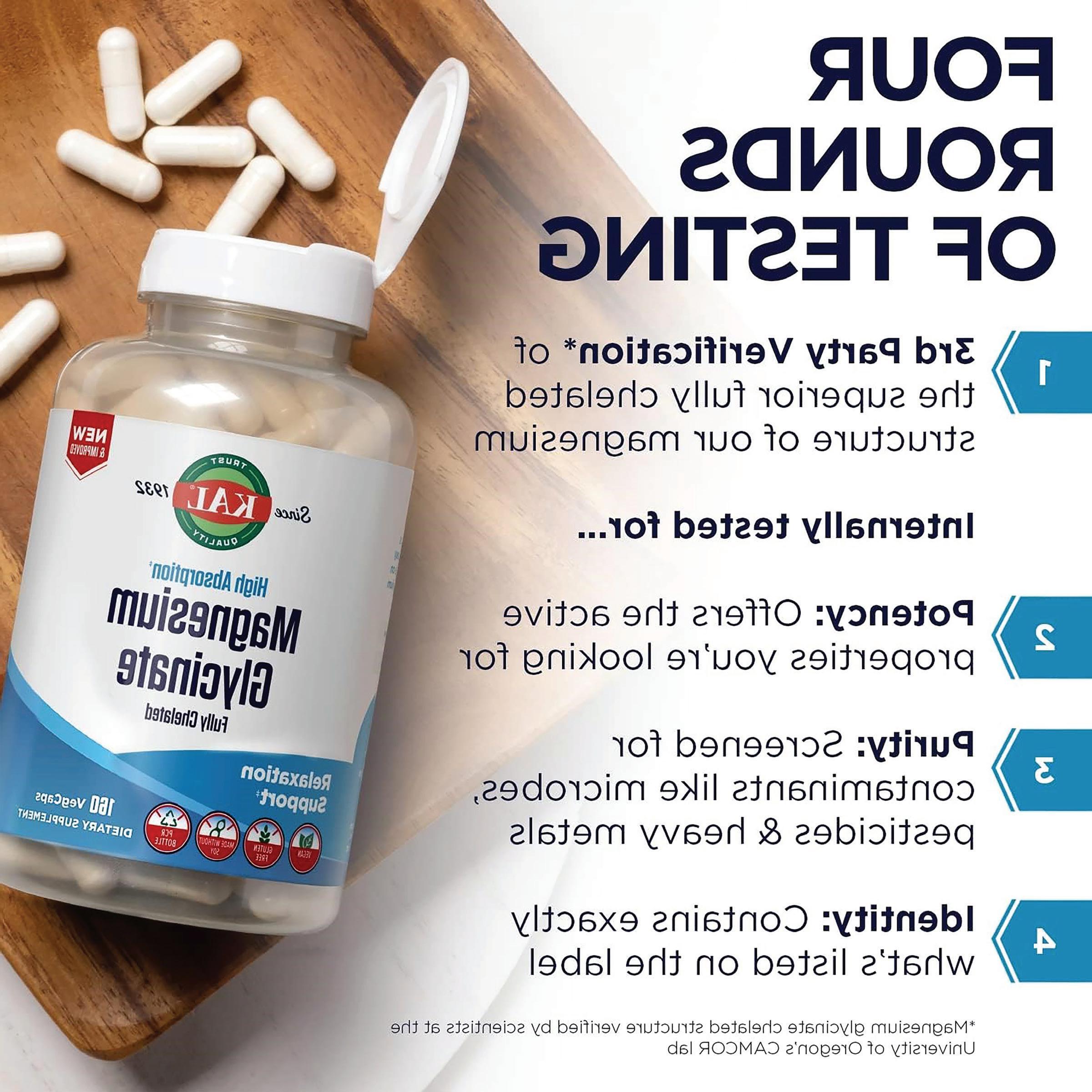





BY MARY ANN O’DELL, MS, RDN

Apple cider vinegar (ACV) is a common household product that has a long history of use. Made by fermentation of apple cider, ACV has a variety of uses, including food preservation, household cleaner, culinary ingredient, therapeutic, and beauty remedy. Many people choose raw ACV over pasteurized because it contains “the mother,” a blend of naturally occurring compounds, including:
✔ Acetic acid—antibacterial, antimicrobial compound
✔ Probiotics—support for the good bacteria in the gut microbiome.
✔ Polyphenols—antioxidants that can help reduce oxidative damage in the body.
It’s these compounds that may be contributing to the health benefits reported for ACV.
Blood Sugar Control. This is one of the most promising areas of use for ACV. A research review looking at 6 studies concluded that consuming 1-2 tablespoons of ACV decreased HbA1C and fasting blood sugar levels. Other studies have demonstrated that vinegar may help improve insulin function and lower blood sugar levels following meals. ACV use should be discussed with a qualified healthcare provider prior to use, especially if you are taking any medication.
Digestive Health. ACV is rich in acetic acid, and as such it is naturally acidic. This fact could explain how ACV may benefit digestion, reducing bloating and gas specifically in those people with low stomach acidity. Some people who experience gastroesophageal reflux disease, or acid reflux, find ACV to be a helpful remedy.
Weight Loss. ACV is touted as a remedy to help with weight loss. While too early to make a claim, some studies do point to a potential role for ACV in weight control. One possible mechanism of action is that ACV may enhance feelings of satiety, which in one study resulted in participants eating 200-275 fewer calories in a day. Benefits appear to be modest, but as a low-calorie food that may also help with blood sugar control, ACV could be a positive addition to a weight control program.
Apple cider vinegar can be added to the diet in dressings and marinades or in health tonics. While it can be consumed diluted as a beverage, excess consumption can erode tooth enamel. Today it is also found in gummies or in convenient capsule form. While research is ongoing on ACV, this folk remedy continues to enjoy the spotlight in the world of health, and its use will likely continue for many years to come. ●

Earth Origins Apple Cider Vinegar
Promotes healthy metabolism.*
Supports healthy blood sugar metabolism, cleansing, and more.*
Made with organic fermented apples, convenient capsule form.

With unbeatable flavor, texture, and nutritional benefits, whole grains comprise most of the world’s diet. Milled into flours, stirred into soups, and topped over salads, whole grains offer protein, fiber, and antioxidants. When three servings of whole grains are consumed per day, the risks for stroke, Type 2 diabetes, and heart disease can be reduced.
Grains are the edible seeds of certain grasses. Corn, pearl barley, rice (brown, black, red, wild), millet, bulgur, quinoa, amaranth, oats (steel-cut, oat groats, oat berries), rye berries and rye flour, wheat berries, farro, and kamut are some familiar (and perhaps not so familiar) examples. To qualify as a whole grain, all three parts of the seed must be present (germ, bran, and endosperm).
Here are some tips to make the most of this versatile food group.
: To add more whole grains to your diet, make these easy swaps.
Ü white breads for whole-wheat bread
Ü standard breakfast cereals for whole-grain versions or hearty oat-based granolas
Ü conventional crackers, pretzels for whole-grain versions
Ü standard pastas for 100 percent whole-wheat pasta; brown rice pasta; buckwheat noodles
: Look for the word whole (whole-wheat flour, whole grain) when shopping for packaged items containing grains. The terms multigrain, wheat bread, or 100 percent wheat are vague and could mean the items were made with white flour.
: When baking, replace ¹⁄³ of the white flour called for with ¹⁄³ cup of whole-wheat flour. This is an easy way to incorporate more whole grains without compromising too much in taste and texture.
: To save money when shopping for whole grains, look for larger containers or bags of whole grains, which typically cost less per ounce.
: Store grains in airtight containers at room temperature away from light and heat to prevent spoilage.
: Rinse grains until the cool water runs clear. Drain grains before preparation. Most grains will approximately triple in volume after being cooked.
: To save time, cook whole grains in advance and freeze them for future meals. Larger grains like brown rice, wheat berries, and wild rice freeze best. After cooking a batch, cool the grains and then spread them loosely apart on a sheet pan. Transfer the sheet pan to the freezer. Once these separate grains are frozen, they can be packaged into freezer bags or freezer-safe containers. Label and freeze. This technique helps prevent grains from freezing into solid chunks.
: If you know kids (or adults) who are picky eaters, increase whole-grain consumption by pairing the grains with assertive flavors and textures. Think sloppy joes served over whole-wheat rolls. Or make a batch of peanut butter cookies with whole-wheat flour.
: Use more spices and seasonings when cooking whole grains. This prevents the whole grain’s bran and germ from becoming the prominent flavors.
: Bowls are a fun way to eat more whole grains. At the bottom of a bowl, layer your favorite grain that’s been tossed in a sauce or dressing. Top with a cooked protein (chopped, ground, or shredded meat, eggs, beans, or tofu). Next, add cooked or raw veggies. Drizzle with a sauce, dressing, or vinaigrette. For the last layer, top the bowl with crunch (seeds, nuts, radish slices, pickled onions, or bean sprouts). ●
SELECTED SOURCES The Complete Beans & Grains Cookbook by America’s Test Kitchen ($34.99, America’s Test Kitchen, 2024) • The Whole Grain Promise by Robin Asbell ($20, Running Press, 2015)
45 min prep time serves 4
From The Complete Beans & Grains Cookbook by America’s Test Kitchen ($34.99, America’s Test Kitchen, 2024)
5 Tbsp extra-virgin olive oil, divided
12 oz broccoli florets, cut into 1½-inch pieces
¾ tsp table salt, divided
¼ tsp black pepper
1½ lb fully cooked Italian chicken sausage
1½ c water
1 c quick-cooking barley
1 oz Parmesan cheese, grated (½ cup)
1 garlic clove, minced
1. Adjust oven rack to lowest position and heat oven to 425°. Brush a rimmed baking sheet with 1 tablespoon of the oil. Transfer sheet to oven and heat until oil is just smoking, 3 to 5 minutes.
2. Toss broccoli with 2 tablespoons of the oil, ½ teaspoon of the salt, and the pepper. Arrange sausage and broccoli in

a single layer on preheated sheet. Roast until sausage is browned on bottom, about 12 minutes. Flip sausage, stir broccoli, and continue to roast until sausage is browned on second side and broccoli is tender, about 12 minutes. Transfer sausage to platter and tent with aluminum foil; transfer broccoli to serving bowl.
3. Meanwhile, bring water and remaining ¼ teaspoon salt to boil in a medium saucepan. Add barley, cover, reduce heat to low, and cook until tender and most of water is absorbed, about 10 minutes.
4. Add barley, Parmesan, garlic, and remaining 2 tablespoons oil to roasted broccoli in serving bowl, toss gently to combine, and season with salt and pepper to taste. Serve with sausage.
Kitchen Note: It’s hard to get more handsoff than this weeknight sheet-pan dinner. While chicken sausage and broccoli roast, quick-cooking barley cooks on the stove and is ready in just 10 minutes. You start by preheating the oven with the sheet pan inside—that way, the fennel-studded Italian chicken sausage and broccoli sizzle when they hit the pan, jump-starting the browning process. Once everything is cooked, just mix the barley into the roasted broccoli, add some garlic and Parmesan, and you’re in business.
Per serving: 794 Calories, 41 g Protein, 176 mg Cholesterol, 45 g Carbohydrates, 7 g Total sugars (0 g Added sugars), 10 g Fiber, 50 g Total fat (12 g sat), 2,005 mg Sodium, ★★★★★ Vitamin B2 (riboflavin), B3 (niacin), B6, C, K, Phosphorus, ★★★★ Vitamin B12, Calcium, ★★★ Vitamin B1 (thiamine), Zinc, ★★ Vitamin E, Folate, Iron, Magnesium, ★ Potassium
To keep cholesterol levels in a healthy range, the American Heart Association (AHA) recommends eating more of these healthy foods:
• Green and root vegetables
• Fresh fruit
• Whole grains
• Low-fat dairy products
• Poultry
• Fatty fish
• Olive oil
• Nuts

protect yourself from this silent risk factor
September is National Cholesterol Education Month, so it’s the perfect time to learn about the risks of high blood cholesterol. Because cholesterol can stealthily clog arteries and restrict blood flow, causing damage without symptoms, many people are unaware they’re at risk for cardiovascular disease.
Cholesterol level checks are a routine part of annual physicals, allowing healthcare providers to measure patients’ low-density lipoproteins (LDL), which cause cholesterol buildup and artery blockage, and high-density lipoproteins (HDL), which help prevent cholesterol buildup.
The goal is to lower levels of both total and “bad” LDL cholesterol while raising “good” HDL cholesterol. Total cholesterol higher than 200 mg/dL, LDL cholesterol higher than 100 mg/dL, and/or HDL cholesterol below 60 mg/dL may be cause for concern, especially if you have other risk factors, such as diabetes, obesity, or a family history of heart disease.
Healthy cholesterol numbers are associated with lower intake of saturated fat, higher intake of soluble fiber, maintaining a healthy body weight, exercising regularly, monitoring blood pressure levels, and not smoking. Lipidlowering statin drugs are often prescribed to lower cholesterol in those for whom lifestyle changes are not working. ●
SELECTED SOURCES “11 foods that can help lower your cholesterol,” Harvard Health Publishing, www.Health.Harvard.edu, 8/1/20 • “Dietary treatment to lower cholesterol and triglyceride and reduce cardiovascular risk” by F.K. Welty, Current Opinion in Lipidology, 8/20 • “The effect of oat beta glucan on LDL-cholesterol, nonHDL-cholesterol, and apoB for CVD risk reduction: A systematic review and metaanalysis of randomized controlled trials” by H.V. Ho et al., British Journal of Nutrition, 10/16 • “Garlic lowers blood pressure . . . regulates serum cholesterol . . .” by K. Ried, Journal of Nutrition, 2/16 • “High blood cholesterol: What you need to know,” National Heart, Lung, and Blood Institute, www.nhlbi.gov • “LDLcholesterol lowering of plant sterols and stanols . . .?” by E.A. Trautwein et al., Nutrients, 9/18 • “Meta-analysis of usefulness of psyllium fiber . . . to enhance cholesterol lowering efficacy of statins” by J. Brum et al., American Journal of Cardiology, 10/18 • “Spices and herbs may improve cardiovascular risk factors” by S.G. West and A.C. Skulas-Ray, Nutrition Today, 11/15
Plant sterols, which are compounds found naturally in many plants, may help to lower cholesterol when included in the diet or as a supplement. Plant-based stanols offer similar heart benefits.
Plant sterols and stanols are collectively called phytosterols and can be found in many foods including beans and legumes (soybeans, peas, kidney beans, and lentils), nuts (pistachios, cashews, macadamia nuts, almonds), and fruit (oranges and bananas), as well as sesame and olive oils.
Besides its popularity in cuisine, garlic is a rising star in cholesterol management. A meta-analysis of randomized, controlled trials points to garlic’s

effectiveness at helping regulate total and LDL cholesterol. The herbs ginger and turmeric may help to decrease total cholesterol, triglycerides, and LDL cholesterol while increasing HDL cholesterol.
Another cholesterol-controlling compound called beta glucan is found in yeast, mushrooms, and oats. Beta glucan binds with cholesterol in your body and gets rid of it.
Psyllium, a type of soluble fiber, helps lower LDL cholesterol levels, “equivalent to doubling the statin dose,” according to a meta-analysis in the American Journal of Cardiology.







Health-Ade Ginger Lemon Organic Kombucha
Bubbly organic probiotic tea for a happy gut.*
Zingy ginger and zesty lemon team up to make it spicy and tangy.
Supplies antioxidants, probiotics, and gut-friendly organic acids.



Amazing Nutrition
Konjac Root 2000mg
Konjac root has long been used as a natural medicine to promote overall health and wellbeing.*
May promote healthy weight management.*
Pure Konjac root, or glucomannan, in capsule form.
Nature’s Way Beet Root
Supports antioxidant pathways.*
Supplies naturally occurring phytonutrients.
1000mg beet root per serving. Convenient capsule form.

Mad Hippie Vitamin C Serum
A harmonious blend of antioxidants help leave skin soft and glowing. Works wonders on aging, sun damaged, and acne-prone skin.
With stable Sodium Ascorbyl Phosphate vitamin C, konjac root, ferulic, and hyaluronic acids.


Bonneval Mineral Water
Pure mineral water from the French Alps.
2000 year natural filtration process.
Respectful and sustainable collection from a spring without drilling.
Still or Sparkling.
Bio Nutrition
Shilajit
May support energy production, cognitive function, and immune health.*
Sourced from the Himalayan region.
500mg per serving, in convenient capsule form.
Natural Vitality Focus Memory & Cognition
Supports focus and concentration, memory, and cognition.*
Pairs potent magnesium L-threonate and phosphatidylserine.
Clinically studied ingredients that can cross the blood-brain barrier.*

Vibriant Health
Maximum Vibrance
Plant-based multisupplement powder.
Packed with vitamins, minerals, antioxidants, and protein, providing a nutrientdense snack.*
Supports endurance, muscle growth, and brain health.*






Earth Origins
Acid Free Vitamin C 1000 mg with Zinc & Botanicals
Provides antioxidant and immune support.*
Gentle non-acidic vitamin C.
In an alkalizing mineral and botanical blend, including bioflavonoids.
*These statements have not been evaluated by the Food & Drug Administration. These products are not intended to diagnose, treat, cure, or prevent any disease. This information is presented as general information and is not meant to replace medical advice. Because persons and circumstances can vary, self treatment may not be right for you. Consult a qualified health care practitioner for advice pertaining to any particular person or case or before beginning any new exercise, diet, or supplementation program. Use products only per label direction.